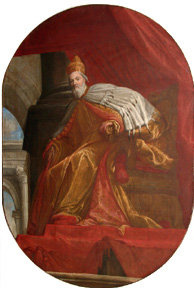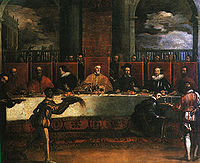
Giovanni I Cornaro
Encyclopedia

Venice
Venice is a city in northern Italy which is renowned for the beauty of its setting, its architecture and its artworks. It is the capital of the Veneto region...
, November 11, 1551 – Venice, December 23, 1629) was the 96th Doge of Venice
Doge of Venice
The Doge of Venice , often mistranslated Duke was the chief magistrate and leader of the Most Serene Republic of Venice for over a thousand years. Doges of Venice were elected for life by the city-state's aristocracy. Commonly the person selected as Doge was the shrewdest elder in the city...
, reigning from January 24, 1625 until his death.
Early years, 1551-1625
He was the son of Marcantonio CornaroCornaro
The Cornaro, also known as Corner, are an illustrious patrician family in Venice, from which for centuries senior office-holders and Doges sprung...
and Cecilia Giustinian. He married Chiara Dolfin on February 10, 1578 and the couple had twelve children.
He served as capitano of Verona
Verona
Verona ; German Bern, Dietrichsbern or Welschbern) is a city in the Veneto, northern Italy, with approx. 265,000 inhabitants and one of the seven chef-lieus of the region. It is the second largest city municipality in the region and the third of North-Eastern Italy. The metropolitan area of Verona...
, before winning a spot on the Council of Ten
Council of Ten
The Council of Ten, or simply the Ten, was, from 1310 to 1797, one of the major governing bodies of the Republic of Venice whose actions were often secretive. Although some sources may indicate that the Council of Ten was generally accepted in Venice, there was some opposition...
in 1597. In 1600, he was made podestà
Podestà
Podestà is the name given to certain high officials in many Italian cities, since the later Middle Ages, mainly as Chief magistrate of a city state , but also as a local administrator, the representative of the Emperor.The term derives from the Latin word potestas, meaning power...
of Padua
Padua
Padua is a city and comune in the Veneto, northern Italy. It is the capital of the province of Padua and the economic and communications hub of the area. Padua's population is 212,500 . The city is sometimes included, with Venice and Treviso, in the Padua-Treviso-Venice Metropolitan Area, having...
, and in 1603, podestà of Brescia
Brescia
Brescia is a city and comune in the region of Lombardy in northern Italy. It is situated at the foot of the Alps, between the Mella and the Naviglio, with a population of around 197,000. It is the second largest city in Lombardy, after the capital, Milan...
. In May 1609, he was named procurator of San Marco
Procurator of San Marco
The office of Procurator of San Marco was the second most prestigious life appointment in the Republic of Venice .-History:...
.
Reign as Doge, 1625-1629
Doge Francesco ContariniFrancesco Contarini
Francesco Contarini was the 95th Doge of Venice, reigning from September 8, 1623 until his death fourteen months later.-Background, 1556-1623:...
died on December 6, 1624. Following a long conclave held on January 4, 1625, the Dogal voters converged on Giovanni Cornaro as their preferred candidate. Cornaro's children were strongly opposed to Cornaro's selection as Doge because of Venice's prohibition on the children of Doges being appointed to high office in government or in the Church.

Pope Urban VIII
Pope Urban VIII , born Maffeo Barberini, was pope from 1623 to 1644. He was the last pope to expand the papal territory by force of arms, and was a prominent patron of the arts and reformer of Church missions...
appointed Cornaro's son Federico Cornaro as a cardinal
Cardinal (Catholicism)
A cardinal is a senior ecclesiastical official, usually an ordained bishop, and ecclesiastical prince of the Catholic Church. They are collectively known as the College of Cardinals, which as a body elects a new pope. The duties of the cardinals include attending the meetings of the College and...
. This move was ultimately ratified by the Senate of Venice, but a latter attempt to make Federico Cornaro Bishop of Vicenza, and later, Bishop of Padua, were successfully blocked.
In 1627, Renier Zen, a Capi of the Council of Ten
Council of Ten
The Council of Ten, or simply the Ten, was, from 1310 to 1797, one of the major governing bodies of the Republic of Venice whose actions were often secretive. Although some sources may indicate that the Council of Ten was generally accepted in Venice, there was some opposition...
, emerged as a vocal critic of Cornaro, accusing him of running Venice for his own family's benefit by, among other things, turning a blind eye to his son Giorgio's trafficking in contraband
Contraband
The word contraband, reported in English since 1529, from Medieval French contrebande "a smuggling," denotes any item which, relating to its nature, is illegal to be possessed or sold....
goods. On October 27, Zen caused an uproar at a meeting of the Great Council by accusing the Cornaro family of corruption; although the elections were annulled, he was unable to obtain any further sanctions. On December 30, Renier Zen was attacked by masked assassins, who were later found to include Giorgio Cornaro, the son of the Doge.
Zen grew even more outspoken in his criticism of Cornaro in the wake of Giorgio Cornaro's failed assassination attempt. Venice now became divided into two factions, a pro-Conaro faction that was pro-papal and backed by the Venetian oligarchs, and a pro-Zen faction that was anti-papal and backed by the poorer nobility (although Zen was probably not the standard bearer for liberty
Liberty
Liberty is a moral and political principle, or Right, that identifies the condition in which human beings are able to govern themselves, to behave according to their own free will, and take responsibility for their actions...
he was sometimes portrayed as in nineteenth-century tragedies). Rioting broke out between the two factions on July 23, 1628, and for the rest of Cornaro's life, Venice was locked in a civil war. The Venetian government had basically broken down by late 1628. Cornaro died on December 23, 1629, with a new war in Montferrat
Montferrat
Montferrat is part of the region of Piedmont in Northern Italy. It comprises roughly the modern provinces of Alessandria and Asti. Montferrat is one of the most important wine districts of Italy...
looming. He and his wife are buried in the Tolentini.

